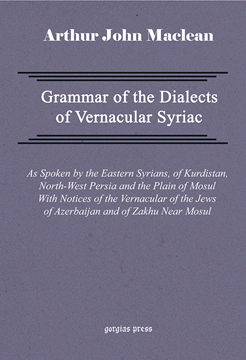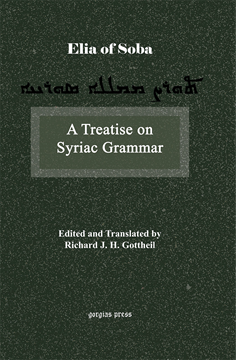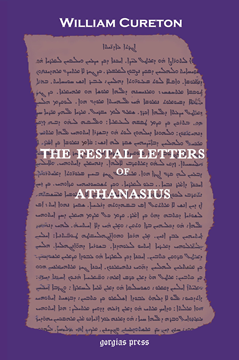Grammar of the Dialects of Vernacular Syriac
ISBN: 1-59333-018-9
The primary grammatical reference for the Neo-Aramaic dialects "spoken by the Eastern Syrians [modern Assyrians & Chaldeans] of Kurdistan, North-West Persia, and the Plain of Mosul," includes notices of the dialects of the Jews of Azerbaijan & Zakhu.
$179.00 (USD)
A Treatise on Syriac Grammar by Mar Elia of Soba
ISBN: 1-59333-019-7
One of the main sources from which the famous Bar Hebraeus might have drawn his knowledge of Syriac grammar to write his semhe. This book is not only important for the history of Syriac grammars, but can be used to learn grammar itself.
$129.00 (USD)
The Festal Letters of Athanasius
ISBN: 1-59333-021-9
The text of the long-lost Festal Letters of St. Athanasius, discovered by Cureton. The volume is dedicated to H.G. Francis, Duke of Bedford.
$77.00 (USD)
Narrative of a Visit to the Syrian [Jacobite] Church of Mesopotamia
ISBN: 1-59333-022-7
Southgate's encounters with the Syriac-speaking Christians of Turkey shed a light on the life and status of this ancient Christian minority.
$154.00 (USD)
The Eucharist Service of the Syrian Orthodox Church: Meaning and Interpretation
By K. P. Paul
ISBN: 1-59333-023-5
An illustrated commentary on the text, meaning and interpretation of the Qurbono (Eucharist Service), including a discussion of all vestments and church parts, written by a leading bishop of the Syriac Orthodox Church from India.
$81.00 (USD)
The Widmanstadt-Moses of Mardin Editio Princeps of The Syriac Gospels of 1555
A Facsimile Limited Numbered Edition with an Introduction by George A. Kiraz
Edited by George Anton Kiraz
ISBN: 1-59333-999-2
A facsimile reprint of the first edition of the Syriac New Testament, published by J. A. Widmanstadius and Moses of Mardin in 1555. This limited collector's edition is custom bound, with long lasting high-quality acid-neutral paper.
$563.00 (USD)
After Life in Roman Paganism
By Franz Cumont
ISBN: 1-931956-37-5
Through the course of eight lectures, Franz Cumont gives a thorough investigation of the afterlife in Roman pagan thought. He covers topics such as the afterlife, celestial immortality, untimely death, the sufferings of hell and metempsychosis, the felicity of the blessed, the journey to the beyond, and more.
$88.00 (USD)
A History of Freedom of Thought
By J. B. Bury
ISBN: 1-931956-39-1
This is a classic book on the history of freedom of thought, covering ancient Greece and Rome, the Middle Ages, and the Renaissance. In addition, this early monograph deals with the Reformation, followed by the seventeenth, eighteenth, and nineteenth centuries.
$63.00 (USD)
Vergil in the Middle Ages
ISBN: 1-931956-35-9
Long before its translation into English, this book secured its author a permanent place in the ranks of European philologists. Comparetti depicts a comprehensive history of the medieval conception of Vergil, then seeks to determine their nature, causes, and connection with European thought.
$125.00 (USD)
A Homeric Dictionary For Use in Schools and Colleges
By Robert Keep
ISBN: 1-59333-027-8
A necessary tool for any student of classics or Homer. A novel feature of the work is the introduction into the text of nearly one hundred and fifty small wood-cut images of various topics.
$119.00 (USD)



![Show details for Narrative of a Visit to the Syrian [Jacobite] Church of Mesopotamia Picture of Narrative of a Visit to the Syrian [Jacobite] Church of Mesopotamia](https://gorgiaspress.com/images/thumbs/0011275_narrative-of-a-visit-to-the-syrian-jacobite-church-of-mesopotamia_360.png)





